A genogram is a valuable tool for visualizing a family's intricate relationships and dynamics. More than just a family tree, a genogram incorporates additional details such as emotional connections, patterns of behavior, and medical histories, making it an essential resource for professionals in fields like psychology, social work, and medicine. This article provides diverse examples, distinguishes them from traditional family trees, and offers a step-by-step guide on creating genograms using an online platform
Why is a Genogram Important?

Genograms serve multiple purposes, offering profound insights into family dynamics and histories. They are particularly important because:
Enhanced Understanding of Relationships: Genograms illustrate not only familial connections but also the quality of relationships, highlighting bonds, conflicts, and patterns that may not be obvious from a standard family tree.
Identifying Patterns and Trends: By mapping out generational patterns, such as mental health issues, addictions, or hereditary diseases, genograms help recognize trends that could impact current and future generations.
Facilitating Communication: For professionals, genograms can be a powerful tool to facilitate discussions with clients or patients about sensitive topics, making it easier to address complex family issues.
Educational and Diagnostic Tool: In academic settings, genograms help students and professionals alike understand family systems and dynamics. In clinical settings, they assist in diagnosing and formulating treatment plans based on the familial context.
Comprehensive Family Overview: Unlike a traditional family tree, a genogram provides a comprehensive overview of the family, including non-biological relationships, social connections, and significant life events.
6 Examples of Genogram
Here are six examples of genograms, each illustrating different aspects and complexities of family dynamics:
Family Genogram
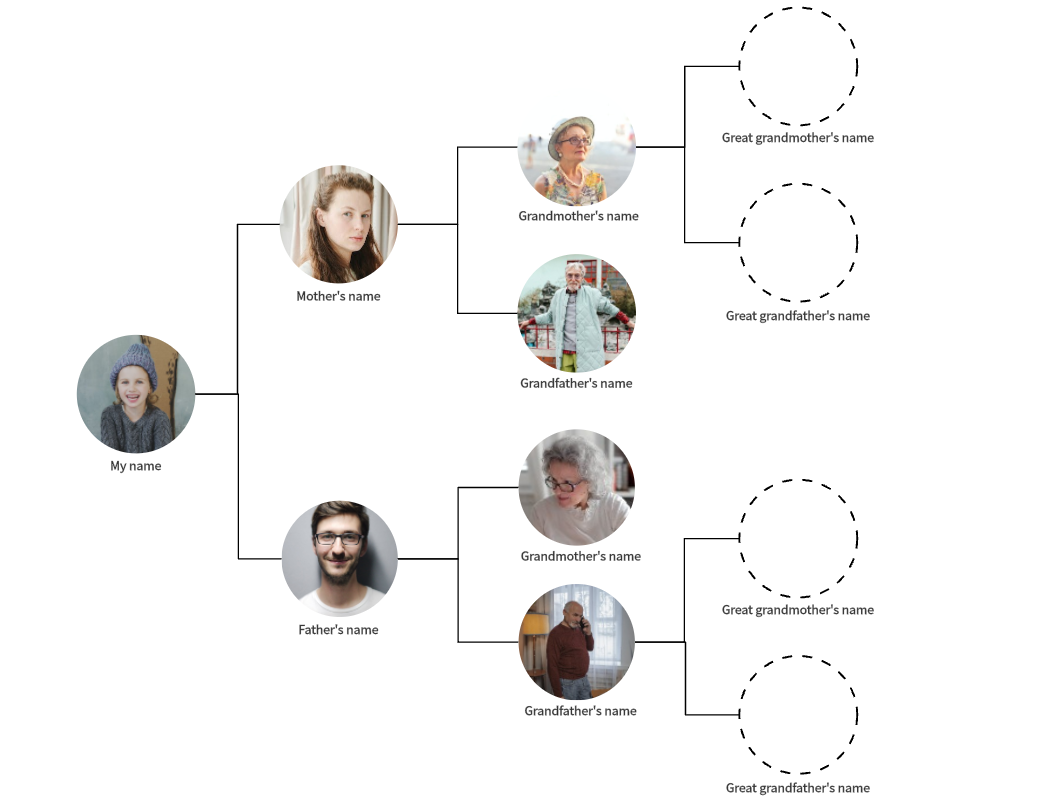
A family genogram is a graphical representation that depicts the structure, relationships, and patterns within a family over multiple generations. Unlike a simple family tree, a genogram provides detailed information about familial connections, including emotional bonds, health histories, and significant life events, making it a valuable tool for various professionals, such as therapists, social workers, and medical practitioners.
A family genogram not only shows the family structure but also highlights health issues such as diabetes, hypertension, substance abuse, and ADHD. It also indicates marital status and emotional relationships, providing a comprehensive overview of the family dynamics.
Medical Genogram
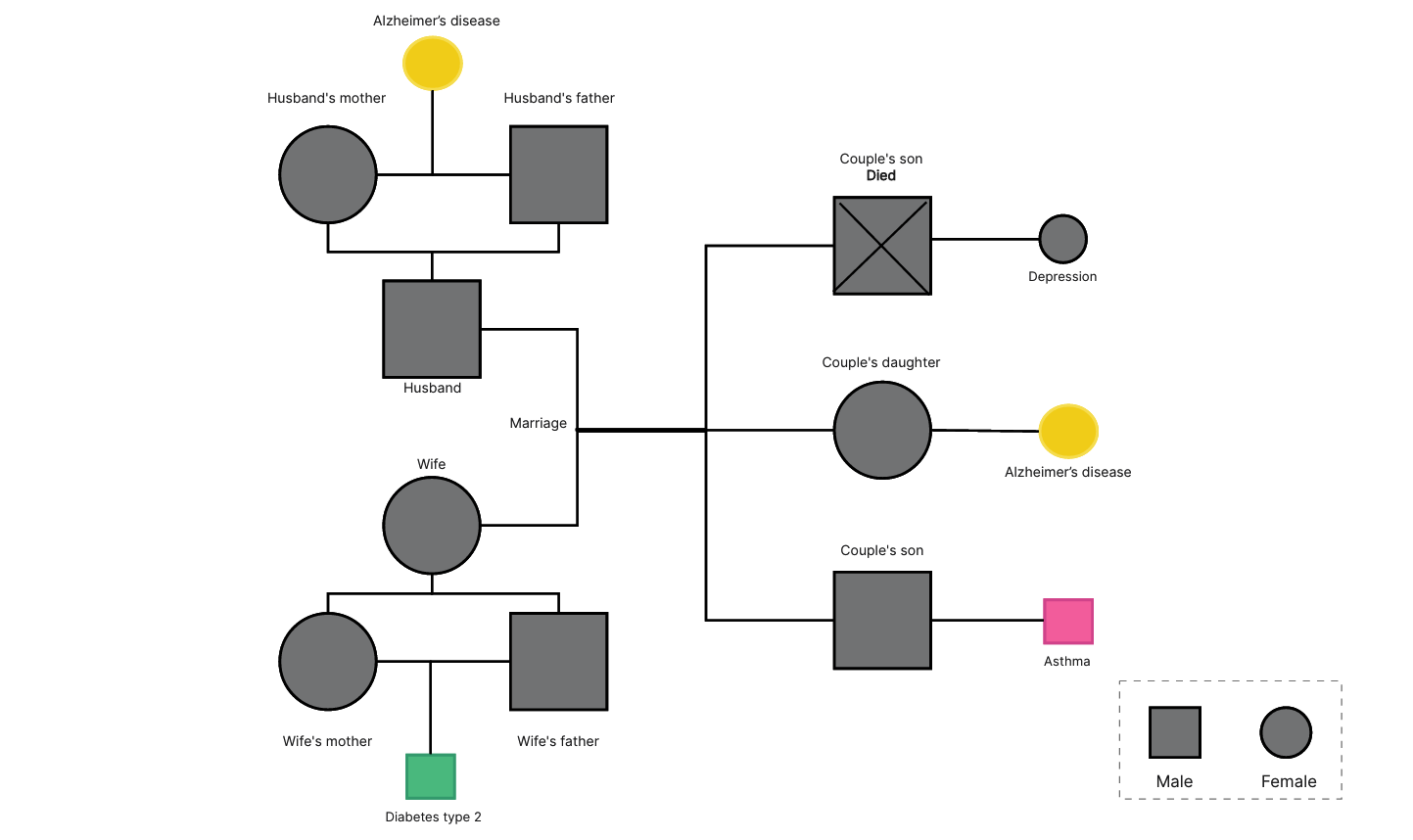
A medical genogram maps out the medical history of family members, indicating genetic disorders, chronic illnesses, and causes of death. his type is particularly useful for healthcare providers to identify hereditary health issues and assess risks for patients. For example, if multiple family members have a history of heart disease, this can alert doctors to monitor at-risk individuals more closely.
Cultural Genogram
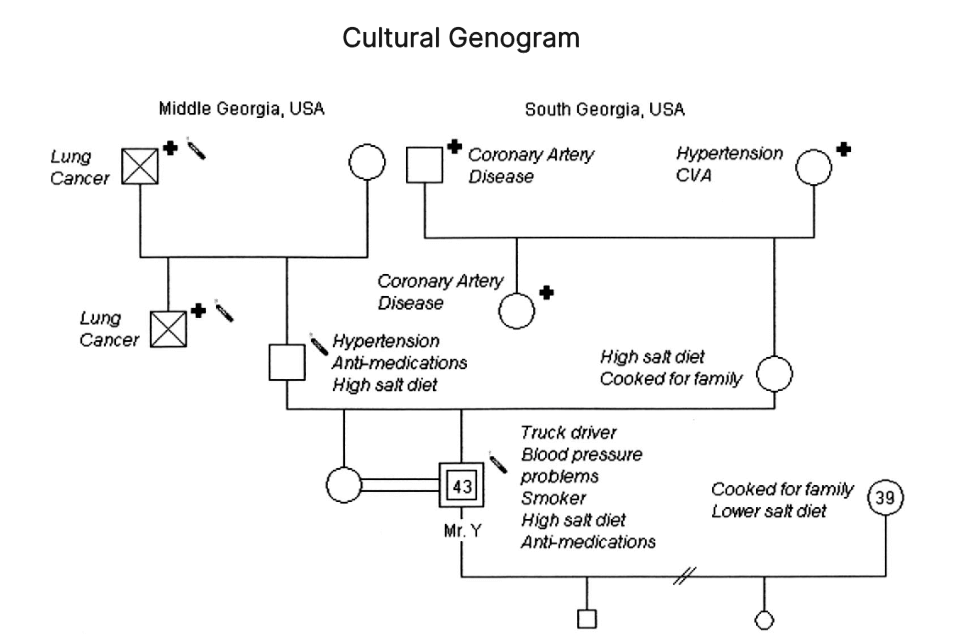
A cultural genogram maps out cultural backgrounds, including ethnicities, traditions, and migration patterns. This type is beneficial for understanding cultural influences on family dynamics. For example, it can show how cultural traditions are passed down and adapted over generations, providing context for current family practices and beliefs.
Mental Health Genogram
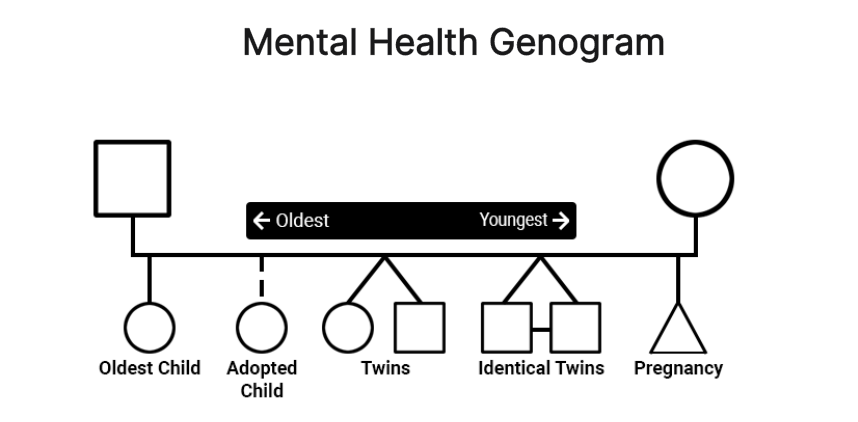
A mental health genogram highlights mental health issues such as depression, anxiety, and bipolar disorder prevalent in the family. Mental health professionals use this type to aid in diagnosis and treatment planning. For example, identifying a history of depression in the family can help in understanding a patient's condition and developing a comprehensive treatment approach.
Occupational Genogram
An occupational genogram shows the occupational paths of family members, revealing trends such as career choices and job stability across generations. Career counselors and social workers can use this type to understand vocational patterns and aspirations within a family. For example, it might highlight a family's tendency toward certain professions, helping to guide career advice and support.
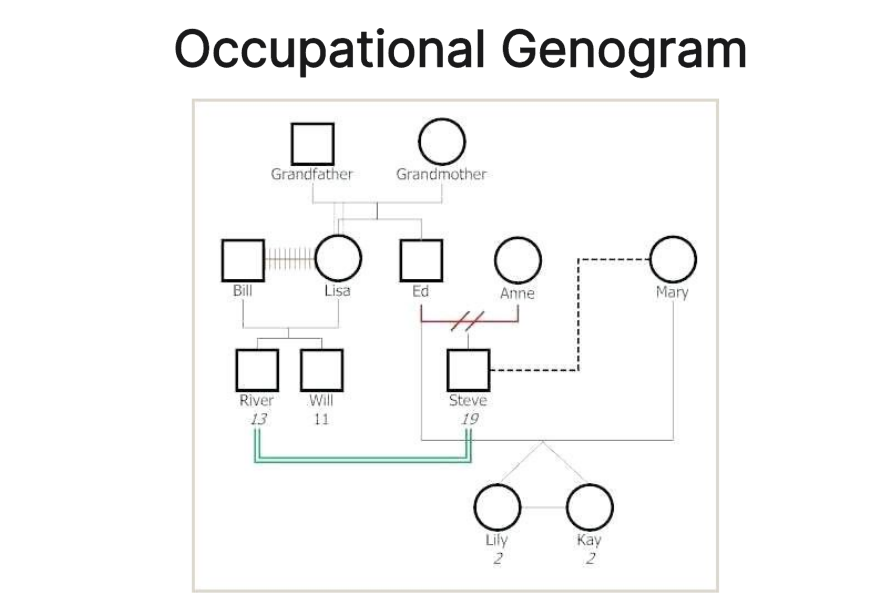
What is the Difference Between a Family Tree and a Genogram?
While both family trees and genograms map out familial connections, they serve different purposes and include distinct types of information:
Detail and Depth: A family tree typically shows basic information such as names, birthdates, marriages, and offspring. A genogram, however, includes detailed information on relationships, medical histories, and significant life events.
Emotional and Behavioral Patterns: Genograms provide insights into the emotional and behavioral patterns within a family, which family trees do not capture. This makes genograms more useful for therapeutic and diagnostic purposes.
Professional Use: Family trees are often used for genealogical research and personal interest. In contrast, genograms are tools used by professionals in psychology, social work, and medicine to understand and address family dynamics and issues.
Symbols and Notations: Genograms use specific symbols and notations to represent different types of relationships, health issues, and other critical information, providing a richer, more nuanced view of the family system.
How to Create Genogram in Boardmix?
Creating a genogram can seem like a daunting task, but with the right tools, the process becomes much simpler. Boardmix offers a user-friendly platform that allows you to create detailed and visually appealing genograms. Follow this step-by-step guide to create a genogram using Boardmix:
Step 1: Start a New Project
Log in to your Boardmix account. If you don't have an account, sign up for one, and click on the "New Project" button. You can choose from available templates or start with a blank canvas.
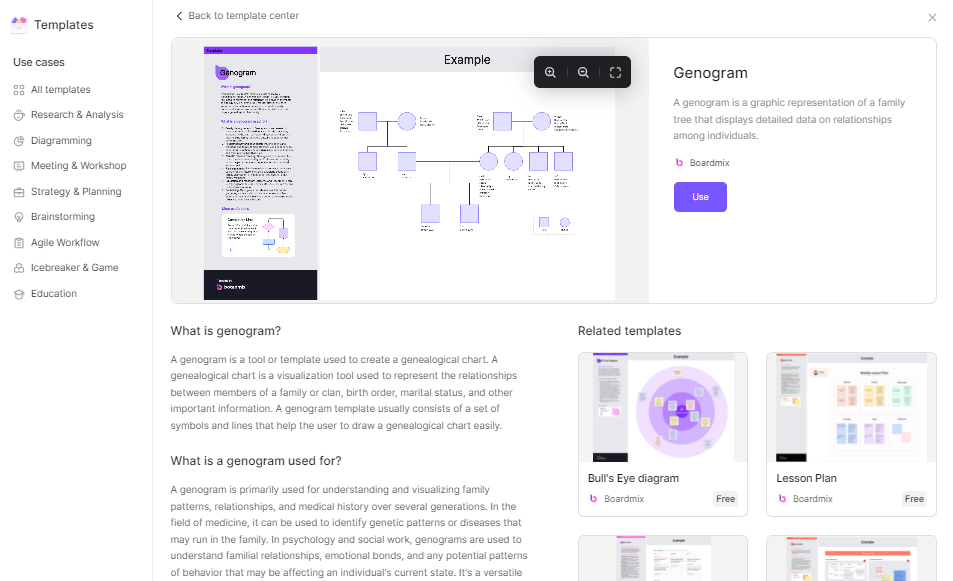
Step 2: Add Family Members
Boardmix provides various symbols to represent family members. Typically, circles represent females, and squares represent males, and drag the symbols onto your workspace. Arrange them to represent different generations, placing older generations at the top and younger generations below. Click on each symbol to add labels. Include the names, birthdates, and any other pertinent information about each family member.
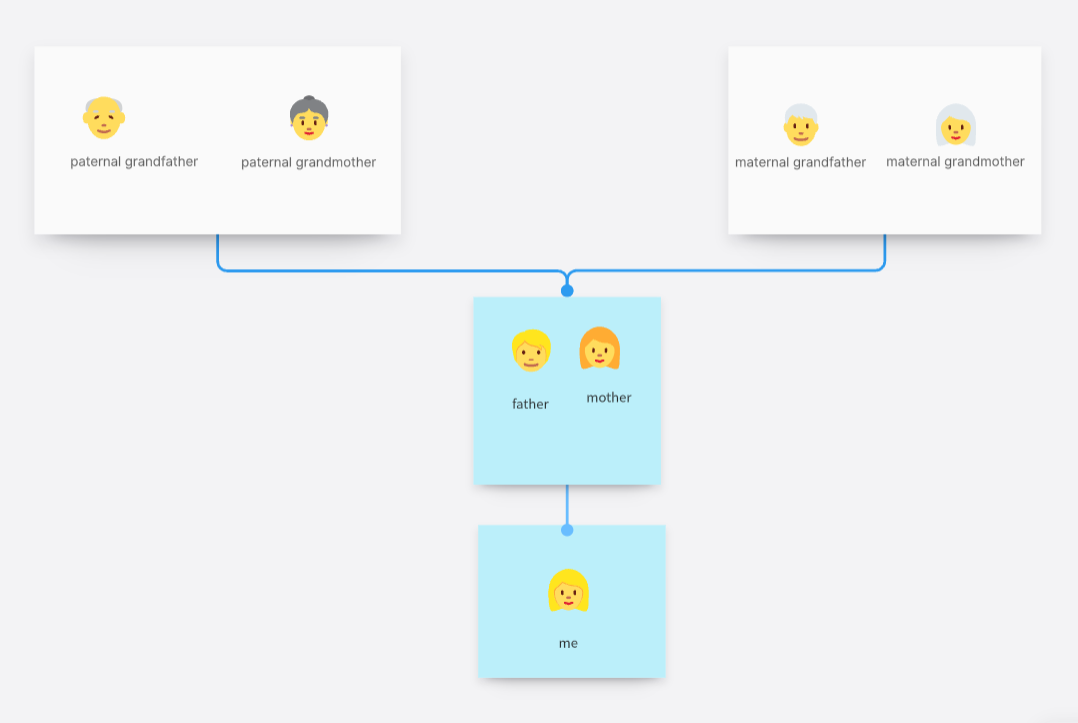
Step 3: Define Relationships
Use lines to connect the symbols, indicating relationships. Solid lines typically represent marriages, while dotted or dashed lines can indicate divorces or separations. Boardmix allows you to customize the lines to show different types of relationships. For example, you can use a specific color or style to indicate strong bonds, conflicts, or estrangement, and add details such as marriage dates, divorce dates, and other significant life events.
Step 4: Add Emotional and Health Information
Use specific notations or colors to represent the quality of relationships (e.g., close, conflicted, distant). This adds depth to your genogram, helping to visualize emotional dynamics within the family. Include symbols or text boxes to denote health issues, such as genetic disorders, chronic illnesses, or mental health conditions. This helps in understanding the health history and patterns in the family.
Step 5: Customize and Review
Boardmix offers various customization options to make your genogram visually appealing and easy to understand. Adjust colors, line styles, and symbols to enhance clarity. Go through the genogram to ensure all information is accurate and complete. Double-check names, dates, relationships, and additional details.
Step 6: Save and Share
Once you are satisfied with your genogram, save it to your Boardmix account. You can also download it in various formats, such as PDF or image files. Boardmix allows easy sharing and collaboration. You can share the genogram with family members, clients, or colleagues by sending them a link or inviting them to view and edit the project.
Genograms are powerful tools that provide deep insights into family dynamics, helping professionals understand and address complex issues. By distinguishing between genograms and traditional family trees, this article highlights the unique benefits of genograms. With tools like Boardmix, creating a comprehensive genogram is more accessible than ever, allowing for detailed analysis and effective communication. Whether for personal use or professional practice, genograms offer invaluable information that can foster understanding and promote positive change within families.








